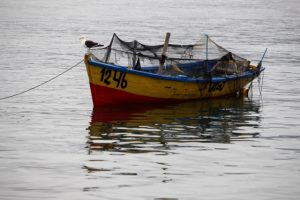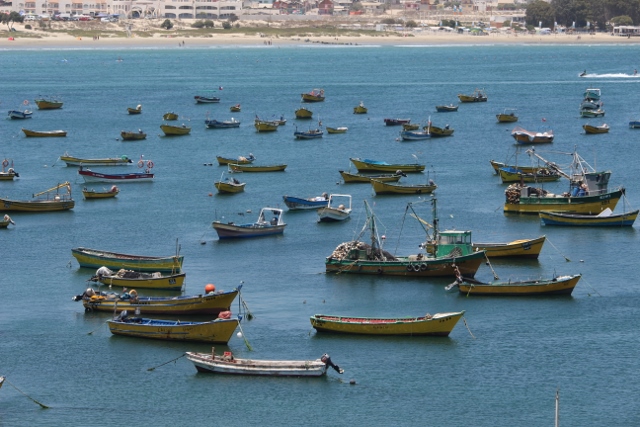La Serena is both humble old town, full of churches, and gaudy beach resort, but without the tourists, yet it benefits from several interesting sites in nearby Coquimbo and Tongoy.
We have turned decisively north. After traveling essentially west for the past weeks, from Buenos Aires all the way to Valparaiso – and after a small detour south, to visit an old friend in Rancagua, just south of Santiago -, we now head north, along the Pacific coast: the main objective of our journey.
First stop is La Serena, five hours by bus. Travel by bus in this part of the world is very comfortable, with spacious, reclining seats, toilet on board, and mostly following the motorway at a monotonous speed, ideal to fall asleep with, if the landscape becomes boring. The landscape on the way to La Serena soon becomes boring, gradually becoming dryer. Even our ‘panorama’ seats, the ones in front on the upper deck, with a 180o wide vista ahead, cannot change that.
We only start paying attention again nearer La Serena, when the road reaches the coast. Long stretches of beach interspersed with rocky promontories. In the mind of every Chilean La Serena comes close to paradise, everybody we talk to is in love with the place. Whether they have been there or not. It being the second oldest town in Chile creates expectations, but we are a bit disappointed, initially. None of the grand old buildings, nothing truly historical – the oldest one we find is from 1895 –, which may have something to do with the frequent earthquakes in this area (the one we felt last week in Santiago also had its epicentre near here). But despite the absence of grand old buildings, the old town does have a certain charm, with narrow streets mostly lined with ground-floor houses only, painted in different colours. The obligatory Plaza de Armas sports a nice, modern fountain, and is full of stalls in anticipation of the Sunday late afternoon, when the population is supposed to come out in force to enjoy a stroll, a look at the obligatory market selling the creations of local artist, and a bite from the equally obligatory artisanal food stalls of the local culinary wizards. But the masses never gather. Once again, it seems that the high season is not really materialising, this year. They blame it on the Argentinians, who didn’t come because of the currency devaluation, and on the earthquake of last week, that scared the beach tourists away.
The other part of town, away from the old centre, is the originally named Avenida del Mar, the road along the coast. The tourist potential is crystal clear here: long sandy beaches, and tower block after tower block of apartments, for rent. Vina del Mar revisited. But it is cloudy, and not very warm. The beaches are almost empty. Later in the afternoon the weather clears up, and more people come out of their condos, with beach umbrellas under their arms. Yet, it never gets very busy. The Argentinians, you know. And the earthquake. Pity that we are not really beach people ourselves.
The next day we make our way to nearby Coquimbo, with two objectives: the local fish market, and a church. The market is fascinating. There are a few stalls along the side of the harbour, where several birds, as well as sea lions, hope to benefit from the offal. But the main market is inside, where once again a wide variety of fish is on sale, as well as a bewildering selection of ceviche cups filled with mussels, prawns and lots of other things, unknown to us. The most catching, but nor very tasty, is the piure, an orange sea fruit that is being wrestled out of a kind of coral-like rock, probably the communal shell of the colony. Outside the market the boats are moored, mostly small-scale affairs, with a few bigger ships – but nothing compared to the floating fish factories we are used to in Europe. Pity that it is, once again, overcast, it doesn’t help the photos.
The second reason to come to Coquimbo is a church. Not the monstrous cross erected on top of the hill, called the Third Millennium Cross, and claimed to be the only religious one of its kind to commemorate the start of the third millennium. One may sincerely hope that there is not a second one like this, indeed! No, the real gem here is a small chapel, built in 1889 from pre-fabricated metal sheets, shipped from Belgium after having been designed by one August Gustave Eiffel, of tower fame. We manage to find the church, in the Guayacan neighbourhood, and with our usual dose of luck, just at that moment the priest turns up to collect something. He happily opens the church for us, allowing a rare non-Sunday glimpse inside. He also tells us that the church was originally constructed as private chapel for the Errazurizs, one of the rich mining families of the town, who lived at the other end of the square – what is now the enormous square in front of the church, then their garden!
A short drive further south gets us past several other beach resorts, mostly more modestly developed than the huge apartment-lined boulevards from La Serena, and indeed Vina del Mar. We park our rental car in Tongoy, where apparently the fish restaurants are the best of the region. Enough reason to come here, I would say.
After lunch, we even stroll along the beach and, lo and behold, dip our feet in the Pacific!
next, Tierra Amarillia, on the way to the Argentinian border again




















































